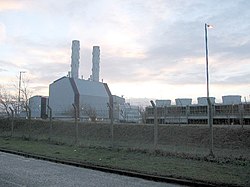Indeed, but then think about it ...
With the combi (or at least this one, a BG branded Worcester Bosch), every 20 mins it fires up. When it fires up it first blows cold air through the main heat exchanger, then it turns on the gas burner and heats everything up, then it turns off the gas and blows cold air through the main heat exchanger for a few seconds (purging POCs), and then shuts down. The main heat exchanger is designed to transfer heat effectively, so it's going to heat the air in the combustion chamber which is able to thermo-syphon out through the air intake (so truly wasted heat). The pipework and DHW heat exchanger are not lagged at all (AIUI some modern boilers to address this to some extent) and so will lose heat readily. All in all, a recipe for wasted heat.
With the thermal store, a large cylinder - so large surface area - and all the associated plumbing. Everything lagged as well as I could, and I even built an insulated cupboard around it. Even so, 80W of leakage doesn't sound too bad. And it's not wasted heat - at least in winter.
This has been the whole argument for not using on/off thermostats with a boiler able to modulate it's output. Whole idea is to cycle the boiler as little as possible. So either a modulating thermostat or control the water through each radiator which in turn controls boiler output.
However the problem is each boiler is different, there is no "This is the best method" and it is so hard to get information as to how much heat is lost through the flue each time the boiler stops and starts.
I had all big ideas of doing it right, however my Bosch Worcester can only it seems use their own thermostat, think called Wave, and this does not connect to eTRV heads, so you can only control one room, and the whole idea of central heating is to heat whole house, so seems rather pointless.
This seems to be repeated though out the domestic central heating systems, it seems the right hand does not know what left hand is doing.
I looked at what seems the Roles Royce of radiators, the Myson ivector it seems to tick every box, until it comes to getting it to talk to the boiler, the building management system is super expensive, clearly not designed for domestic use, but they are it seems able to connect to both heating and cooling, so for an integrated system there is no option but the fan assisted radiator.
But then the big question, why do we need a fully automated system, is it so hard to turn heating on/off?
As any gas boiler gets bigger you can extract more and more energy from the gas, when gas is burnt it both gets hot and increases in volume, so any efficient system must use both,
I have two both within two miles of where I live, both are combined power and both are far more efficient to any domestic boiler, why two just 1 mile apart not a clue, 1,420 MW and 498 MW the first the steam turbines are on the end of the gas turbine shaft, the second the steam turbine is separate. But using electric power from these to boil the kettle is far more efficient than using gas direct. However that does not mean cheaper, and it is all down to a balance, including how much we want to automate, and how much we will do for our selves.
Instead of having a super quick boiling device for my coffee, I could take the kettle into the living room, and watch TV while boiling the water. Or even have a TV in the kitchen. If I have a house full of visitors all wanting coffee, then filling the two one cup boilers with warm water would speed things up, or I could take the filter coffee maker into living room with a jug of milk, and bowl of sugar and let everyone help them selves. Bound to be some one who wants sweetener, or caffeine free or some other weird request.
So eco hot drink making, why not an insulated coffee pot, or cup, or even kettle so no heat lost, I have considered a tea cosy for pans, with an induction hob no fire risk, so no reason why a simmering pan should not have insulated sides and lid. But then we also want it dish washer proof etc.
So today's method has stood the test of time, it has not broken so why change it.



